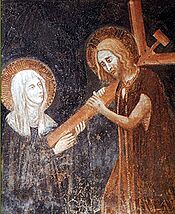Clare of Montefalco facts for kids
Quick facts for kids SaintClare of Montefalco |
|
|---|---|

Christ implanting his Cross in the heart of Saint Clare of Montefalco
|
|
| Saint Clare of the Cross | |
| Born | 1268 Montefalco, Umbria, Italy |
| Died | 18 August 1308 Montefalco, Umbria, Italy |
| Venerated in | Roman Catholicism |
| Beatified | April 1, 1828, Rome by Pope Clement XII |
| Canonized | December 8, 1881, Rome by Pope Leo XIII |
| Major shrine | Church of Saint Clare, Montefalco |
| Feast | August 17 |
| Attributes | Cross |
| Patronage | Montefalco |
Clare of Montefalco (Italian: Chiara da Montefalco) (c. 1268 – August 18, 1308), also called Saint Clare of the Cross, was an Augustinian nun and abbess. Before becoming a nun, Clare was a member of the Third Order of St. Francis (Secular). She was canonized by Pope Leo XIII on December 8, 1881. She differs from Clare of Assisi (1194 – 1253), a contemporary of St Francis and the founder of an order of Poor Clares.
Life
Clare was born in Montefalco, in Umbria, likely in the year 1268. She was born into a well-to-do family, the daughter of Damiano and Iacopa Vengente. Her father, Damiano, had built a hermitage within the town of Montefalco. Clare's older sister Joan (Giovanna in Italian) and her friend Andreola lived as Franciscan tertiaries in that hermitage as part of the Secular Third Order of St. Francis. In 1274, when Clare was six years of age, the Bishop of Spoleto permitted Joan to receive more sisters, and it was at this time that Clare joined the Third Order of St. Francis (Secular), moving into the hermitage and adopting the Franciscan habit. In 1278, the community had grown sufficiently large that they had to build a larger hermitage farther from town.
In 1290, Clare, her sister Joan, and their companions sought to enter the monastic life in a more strict sense, and they made application to the Bishop of Spoleto. As the Third Order of St. Francis (Regular) was not yet established, the bishop established their monastery adjacent to the church of Sant'Illuminata in Montefalco according to the Rule of St. Augustine. Clare made her vows of poverty, chastity, and obedience and became an Augustinian nun. Her sister Joan was elected as the first abbess, and their small hermitage (built and funded by their father) was dedicated as a monastery. On November 22, 1291, Joan died, after which Clare was elected abbess. She was initially reluctant to accept her position, but did so after the intervention of the Bishop of Spoleto.
1294 was a decisive year in Clare's spiritual life. During the celebration of the Epiphany, after making a general confession in front of all her fellow nuns, she fell into ecstasy and remained in that state for several weeks. Since she was unable even to eat during this period, the other nuns sustained Clare's life by feeding her sugar water. During this time, Clare reported having a vision in which she saw herself being judged in front of God.
Clare also reported having a vision of Jesus dressed as a poor traveller. She described his countenance as being overwhelmed by the weight of the cross and his body as showing signs of fatigue. During the vision, Clare knelt in front of him, and whilst trying to stop him she asked, "My Lord, where art Thou going?" Jesus answered her: "I have looked all over the world for a strong place where to plant this Cross firmly, and I have not found any". After she reached for the cross, making known her desire to help him carry it, He said to her: "Clare, I have found a place for My cross here. I have finally found someone to whom I can trust Mine cross," and he implanted it in her heart. Clare took her belief in this vision seriously. The rest of her years were spent in pain and suffering, yet she continued to joyfully serve as abbess, teacher, mother and spiritual directress of her nuns. While Clare's reputation for holiness and wisdom attracted visitors to the Monastery of the Holy Cross, she proved to be worldly-wise and canny in the way she governed her monastery. She was careful not to disrupt the communal harmony and the necessary day-to-day management of the monastery's domestic affairs.
In 1303, Clare was able to build a church in Montefalco which would not only serve as a chapel for the nuns, but also as a church for the town. The first stone was blessed by the Bishop of Spoleto on June 24, and that day the church was dedicated to the Holy Cross (Santa Croce); the remnant portion of that small church comprises the frescoed Chapel of Santa Croce connected to the larger Santa Chiara in Montefalco.
Clare had served as abbess for sixteen years. By August 1308, she had become so ill that she was bedridden. On August 15, she asked to receive Extreme Unction, and on the next day she sent for her brother to come to the monastery. Clare made her last confession on August 17, and died at about 40 years of age in the convent on August 18.
Canonization
The canonization process was initiated in 1328, but it was not until April 13, 1737, that Clare was beatified by Pope Clement XII. On December 8, 1881, the feast of the Immaculate Conception, Pope Leo XIII canonized Clare as Saint Clare of Montefalco at Saint Peter's Basilica in Rome. She was recognized as an Augustinian rather than a Franciscan.
See also
 In Spanish: Clara de la Cruz para niños
In Spanish: Clara de la Cruz para niños
- Incorruptibility
- List of Catholic saints

